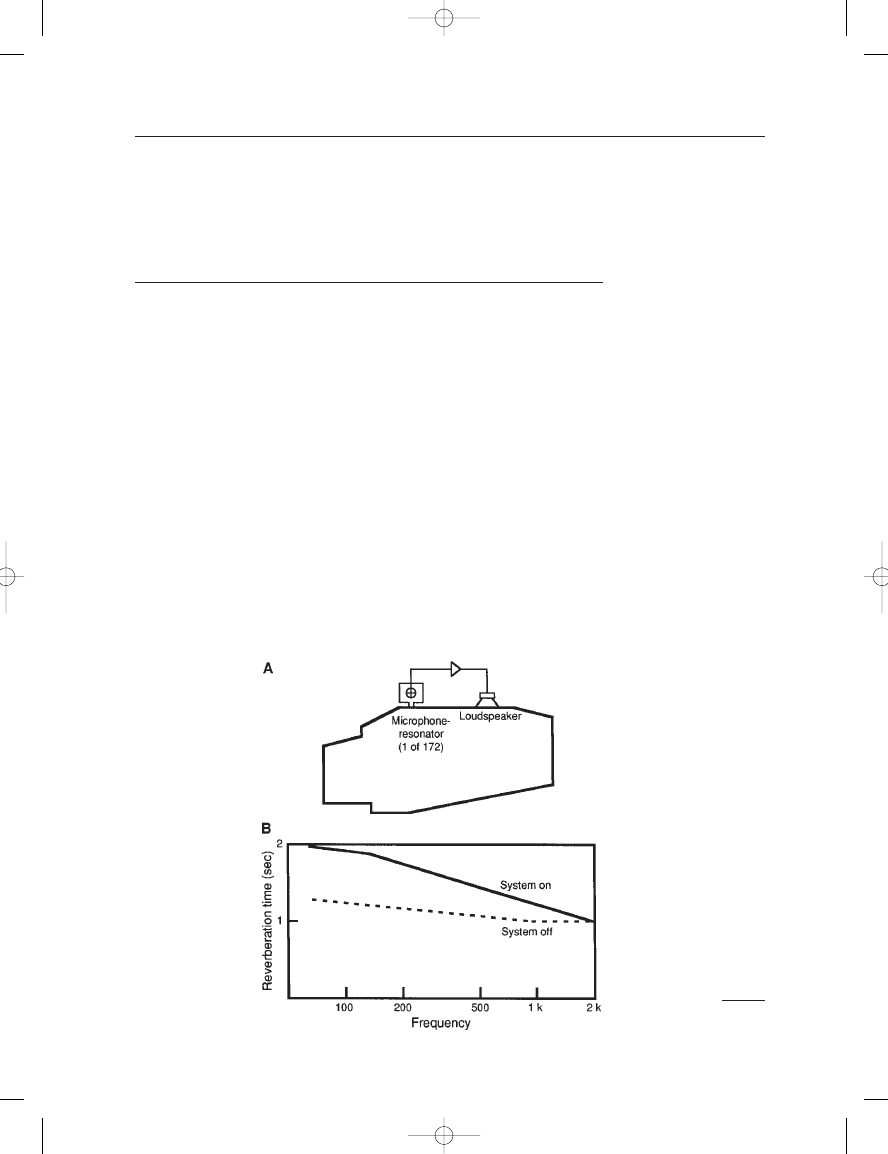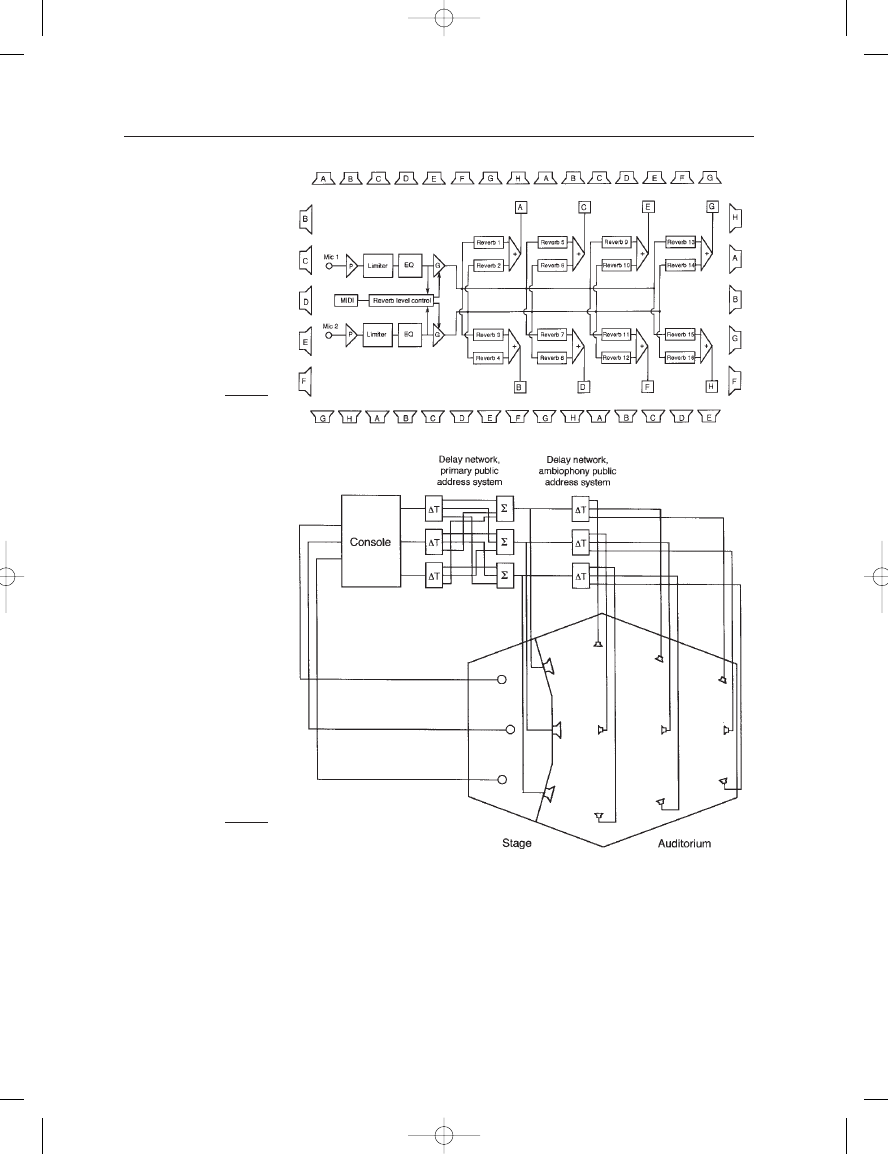ВУЗ: Казахская Национальная Академия Искусств им. Т. Жургенова
Категория: Книга
Дисциплина: Не указана
Добавлен: 03.02.2019
Просмотров: 17251
Скачиваний: 51

Based on this observation, the acoustician and architect may find com-
mon ground between them for improving the estimate. Most notably, a
reduction of reverberation time (difficult, and often costly, to accomplish)
or an improvement in loudspeaker coverage for higher direct sound levels
(easier to accomplish) might be considered.
SPEECH AND MUSIC REINFORCEMENT IN THE
LEGITIMATE THEATER
Traditionally, legitimate theaters and playhouses have been fairly small
spaces, and professional actors have long been known for their ability to
fill a house without electroacoustical assistance. This is still the model in
most established venues. However, modern venues tend to be larger than
earlier ones, and the proliferation of multi-purpose halls can result in
staging of drama in houses that are actually too large for the purpose. In
these cases a speech reinforcement strategy as shown in Figure 18–17 is
very effective. Here, three boundary layer microphones are placed on the
apron of the stage as shown. Ideally, these microphones should be in the
direct field of the actors, but in some large houses the microphones may
be in the transition region between direct and reverberant fields.
The signals are routed to carefully equalized and delayed loud-
speaker channels located in the proscenium. In many cases, the acousti-
cal gain of the system at mid-frequencies may be virtually none; the
important effect of the system is the amplification of high frequencies,
which enhances intelligibility. The purpose of the delay is to ensure that
the first-arrival sound at the listeners is from the stage.
If omni microphones can provide the requisite gain at high frequen-
cies, they are the first choice. If cardioid microphones are needed for
THE MICROPHONE BOOK
318
FIGURE 18–17
Stereophonic reinforcement
of speech in the legitimate
theater: stage layout (A);
actor-microphone
relationship (B); typical
electrical channel (C).
Earg_18.qxd 14/9/04 3:02 PM Page 318

feedback minimization, be aware that footfalls on the stage may become
a problem, which will require high-pass filtering.
Special effects and off-stage events are normally handled by a sound
designer and may be fed into the house from a variety of directions.
THE MODERN MUSICAL THEATER
Since the rock musicals of the 1960s, sound reinforcement has become a
requirement in the musical theater, both for pit musicians and singer–
actors on stage. Today, hardly a touring company goes on the road with-
out a sound specialist and all the necessary equipment to do the job right.
Here are some of the microphone requirements:
1. On-stage: Singers wear wireless tie-tack microphones, usually
positioned at the middle of their hairlines. This affords complete
freedom of movement and expression. See the notes in Chapter 9
regarding the use of large numbers of wireless microphones.
2. Overhead pickup: Rifle microphones may be flown to pick up some
degree of stage ambience or group action.
3. Orchestra pit: The pit orchestra has always been limited in personnel,
and individual clip-on microphones may be used on each instrument.
These signal outputs must be pre-mixed to give the front-of-house
(FOH) mixer the necessary flexibility in handling the overall produc-
tion. Assistant mixers may be needed in complex situations.
Loudspeakers are normally deployed in vertical columns at the sides
of the stage, with other loudspeakers positioned in the house as neces-
sary for special effects.
HIGH-LEVEL CONCERT SOUND REINFORCEMENT
The mega-event concert performance of a major pop/rock artist is usually
presented in a large indoor arena, outdoor stadium, or even an expansive
field. Patrons pay dearly for front seats, and even those who are seated at
great distances will expect sound pressure levels in the 110–115 dB range.
Most of the instruments have direct feeds to the console, and only
vocals, drums and an occasional wind instrument will actually require
microphones. All microphones are positioned very close to the sound
sources to minimize feedback since on-stage monitoring levels can be
very high. Vocalists–instrumentalists in particular have gravitated to
head-worn microphones, since these give freedom of movement as well
as a very short and consistent operating distance for vocal pickup. A solo
vocalist may still prefer a handheld microphone since this has long been
a standard “prop” onstage.
A potential source of feedback is from stage floor monitor loud-
speakers operating at high levels into the performer’s microphones, even
18: Fundamentals of Speech and Music Reinforcement
319
Earg_18.qxd 14/9/04 3:02 PM Page 319

when those microphones are operated at very short distances. As a hedge
to this, a new technique known as in-the-ear monitoring has become
popular. It uses small receivers that are actually placed in the wearer’s ear
canal, with operating levels carefully monitored.
ACTIVE ACOUSTICS AND ELECTRONIC HALLS
The field of active acoustics has been around for at least three decades and
has made steady but gradual progress. One of the earliest systems was
assisted resonance (Parkin, 1975). The first notable installation was in
London’s Royal Festival Hall. The hall lacked sufficient volume for its seat-
ing capacity and target reverberation time, and the system was installed to
increase reverberation time in the range 60–700 Hz. The system consists of
172 channels. Each channel contains a microphone placed in a Helmholtz
resonator, amplifier, and a loudspeaker. The microphones are positioned
well in the reverberant field. Because of their narrow frequency bands the
individual channels are quite stable, and the increase in apparent reverber-
ation time results from the high-Q nature of each resonator. Figure 18–18A
shows a view of a single channel, while the increase in reverberation time,
with the system on and off, is shown at B.
LARES stands for Lexicon Acoustical Reverberance Enhancement
System. The system consists of a set of Lexicon reverberation channels
randomly feeding an ensemble of loudspeakers. Microphones are located
above and in front of the performance area. The increase in reverbera-
tion time is the result of the reverberation generators themselves, and the
gain of the systems is stabilized by randomly varying delay sections in
THE MICROPHONE BOOK
320
FIGURE 18–18
Parkin’s assisted resonance.
Earg_18.qxd 14/9/04 3:02 PM Page 320

each reverberation channel. Reverberation time is independently
adjustable and is not dependent on reverberant level. A signal flow dia-
gram for the system is shown in Figure 18–19.
Delta stereophony, shown in Figure 18–20, is used to increase loud-
ness of stage events without compromising the natural directional cues
from the stage. The system includes loudspeakers positioned at stage
level as well as overhead. The number of delay channels normally does
not exceed about six or eight, and the system is easily reconfigured for
various kinds of stage events.
18: Fundamentals of Speech and Music Reinforcement
321
FIGURE 18–19
The LARES system.
FIGURE 18–20
Delta stereophony.
Earg_18.qxd 14/9/04 3:02 PM Page 321

C
H
A
P
T
E
R
1
9
OVERVIEW OF MICROPHONE
ARRAYS AND ADAPTIVE
SYSTEMS
INTRODUCTION
A microphone array may be considered to be a set of microphone
elements arrayed in space whose outputs are individually processed and
summed to produce a given output. In a basic sense, an early cardioid
microphone created by summing separate pressure and gradient elements
may be thought of as an array, but this is not what we have in mind. The
arrays and techniques discussed here normally use multiple elements to
achieve a target directional response that may be specific for a given
application. In other cases, signal processing may be applied to single
microphones, or microphone channels, to enhance performance in some
unique respect.
Adaptive systems are those whose signal processing coefficients
change over time in order to accommodate or maintain a given signal con-
trol parameter. Basic adaptive techniques will be discussed as they apply to
echo cancellation and as they are used to simulate, via data reduction
techniques, the output of microphones in recording applications. Other
applications of adaptive techniques deal with the manipulation of array
directivity as a function of source tracking or other requirement. The
discussion begins with basic line array theory.
DISCRETE LINE ARRAY THEORY
The simplest line array consists of a group of equally spaced micro-
phones whose outputs are summed directly. Let us assume a set of
four omnidirectional microphones arrayed vertically, as shown in
Figure 19–1. Let the spacing, d, between adjacent line elements be 0.1 m
Earg_19.qxd 14/9/04 3:04 PM Page 322